Commercial Law Analysis: Faltex, Competition Law, and Market Dynamics
VerifiedAdded on 2022/10/15
|6
|1618
|20
Report
AI Summary
This report analyzes the commercial law implications of Faltex Limited's operations within the Australian fuel market. The report examines Faltex's market share, its relationship with competitors (Scottish Petroleum Ltd, Kangaroo Petroleum Ltd, and Redback Oil Ltd), and its compliance with the Competition and Consumer Act 2010 (CCA). The analysis focuses on potential anti-competitive behavior, including price fixing and market dominance, and assesses whether Faltex's actions, including potential acquisitions, comply with the CCA's provisions. The report also explores the concepts of mergers, acquisitions, and creeping acquisitions, providing insights into how these activities are regulated under Australian law. Furthermore, it provides context by discussing a case involving APA Group and CK Infrastructure Holdings, highlighting the importance of competition law in protecting consumer welfare and preventing monopolies. The report uses the provided data to assess Faltex's position and potential acquisition of Redback Oil Ltd, considering whether such actions would be permissible under the CCA.
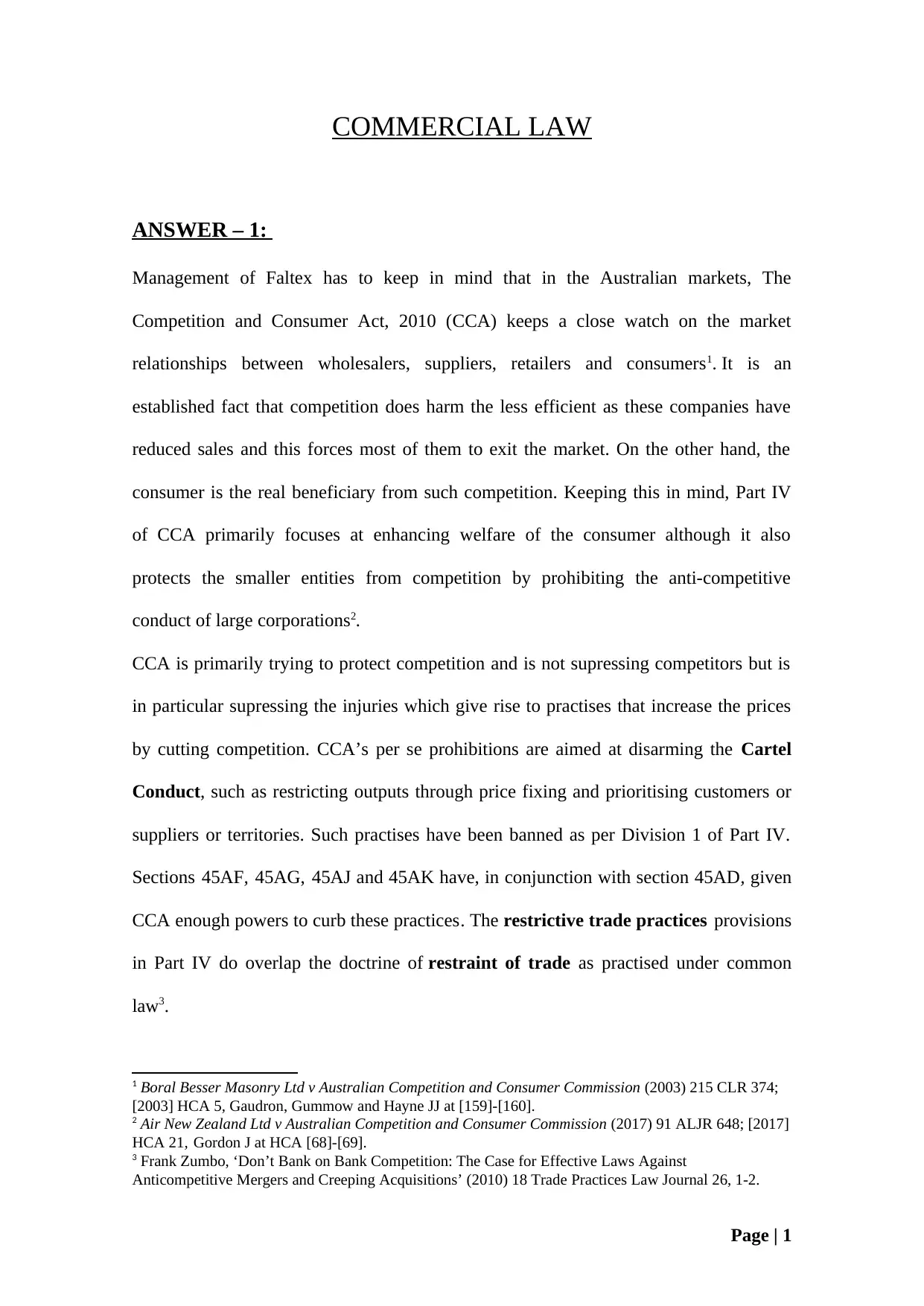
COMMERCIAL LAW
ANSWER – 1:
Management of Faltex has to keep in mind that in the Australian markets, The
Competition and Consumer Act, 2010 (CCA) keeps a close watch on the market
relationships between wholesalers, suppliers, retailers and consumers1. It is an
established fact that competition does harm the less efficient as these companies have
reduced sales and this forces most of them to exit the market. On the other hand, the
consumer is the real beneficiary from such competition. Keeping this in mind, Part IV
of CCA primarily focuses at enhancing welfare of the consumer although it also
protects the smaller entities from competition by prohibiting the anti-competitive
conduct of large corporations2.
CCA is primarily trying to protect competition and is not supressing competitors but is
in particular supressing the injuries which give rise to practises that increase the prices
by cutting competition. CCA’s per se prohibitions are aimed at disarming the Cartel
Conduct, such as restricting outputs through price fixing and prioritising customers or
suppliers or territories. Such practises have been banned as per Division 1 of Part IV.
Sections 45AF, 45AG, 45AJ and 45AK have, in conjunction with section 45AD, given
CCA enough powers to curb these practices. The restrictive trade practices provisions
in Part IV do overlap the doctrine of restraint of trade as practised under common
law3.
1 Boral Besser Masonry Ltd v Australian Competition and Consumer Commission (2003) 215 CLR 374;
[2003] HCA 5, Gaudron, Gummow and Hayne JJ at [159]-[160].
2 Air New Zealand Ltd v Australian Competition and Consumer Commission (2017) 91 ALJR 648; [2017]
HCA 21, Gordon J at HCA [68]-[69].
3 Frank Zumbo, ‘Don’t Bank on Bank Competition: The Case for Effective Laws Against
Anticompetitive Mergers and Creeping Acquisitions’ (2010) 18 Trade Practices Law Journal 26, 1-2.
Page | 1
ANSWER – 1:
Management of Faltex has to keep in mind that in the Australian markets, The
Competition and Consumer Act, 2010 (CCA) keeps a close watch on the market
relationships between wholesalers, suppliers, retailers and consumers1. It is an
established fact that competition does harm the less efficient as these companies have
reduced sales and this forces most of them to exit the market. On the other hand, the
consumer is the real beneficiary from such competition. Keeping this in mind, Part IV
of CCA primarily focuses at enhancing welfare of the consumer although it also
protects the smaller entities from competition by prohibiting the anti-competitive
conduct of large corporations2.
CCA is primarily trying to protect competition and is not supressing competitors but is
in particular supressing the injuries which give rise to practises that increase the prices
by cutting competition. CCA’s per se prohibitions are aimed at disarming the Cartel
Conduct, such as restricting outputs through price fixing and prioritising customers or
suppliers or territories. Such practises have been banned as per Division 1 of Part IV.
Sections 45AF, 45AG, 45AJ and 45AK have, in conjunction with section 45AD, given
CCA enough powers to curb these practices. The restrictive trade practices provisions
in Part IV do overlap the doctrine of restraint of trade as practised under common
law3.
1 Boral Besser Masonry Ltd v Australian Competition and Consumer Commission (2003) 215 CLR 374;
[2003] HCA 5, Gaudron, Gummow and Hayne JJ at [159]-[160].
2 Air New Zealand Ltd v Australian Competition and Consumer Commission (2017) 91 ALJR 648; [2017]
HCA 21, Gordon J at HCA [68]-[69].
3 Frank Zumbo, ‘Don’t Bank on Bank Competition: The Case for Effective Laws Against
Anticompetitive Mergers and Creeping Acquisitions’ (2010) 18 Trade Practices Law Journal 26, 1-2.
Page | 1
Paraphrase This Document
Need a fresh take? Get an instant paraphrase of this document with our AI Paraphraser
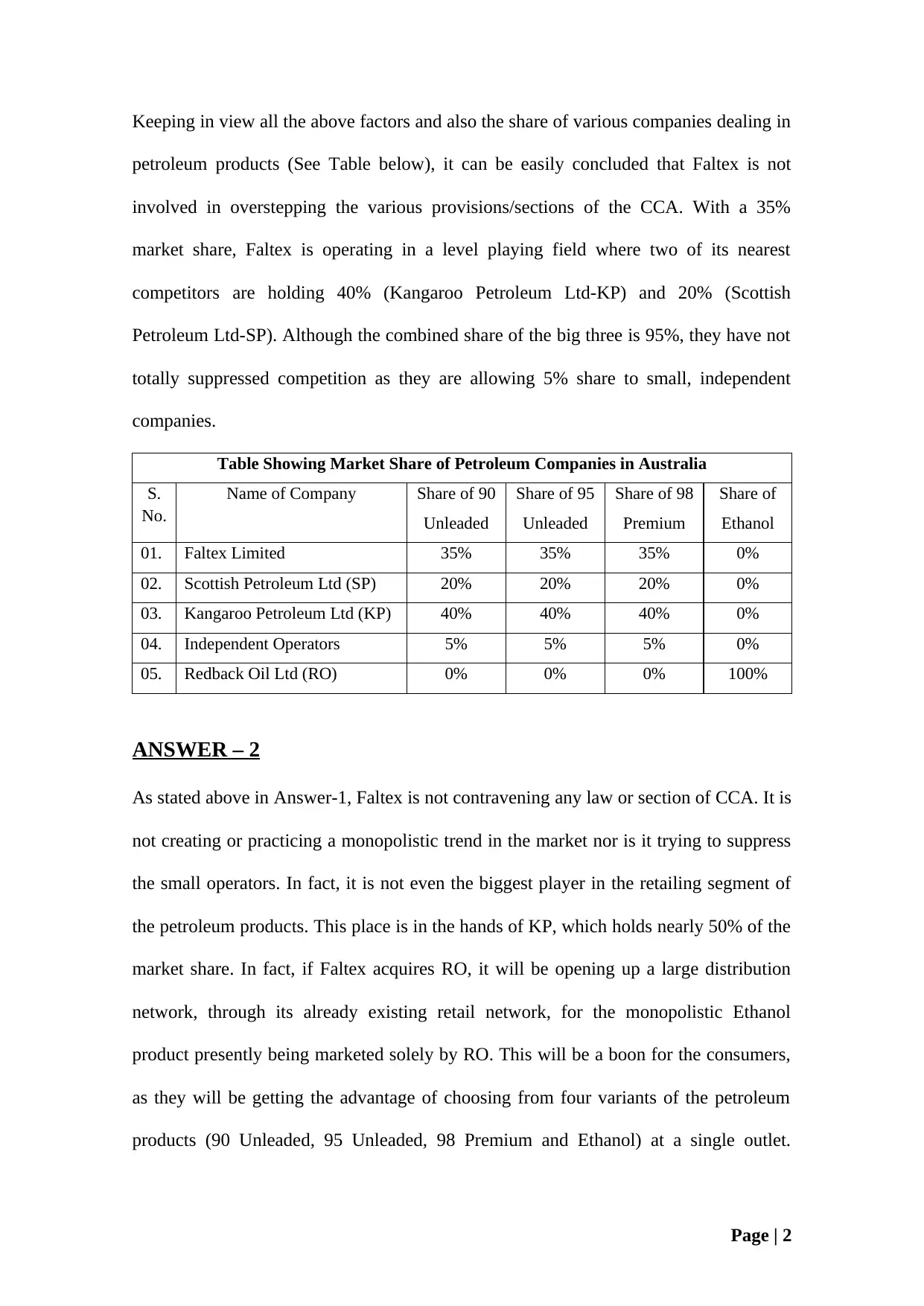
Keeping in view all the above factors and also the share of various companies dealing in
petroleum products (See Table below), it can be easily concluded that Faltex is not
involved in overstepping the various provisions/sections of the CCA. With a 35%
market share, Faltex is operating in a level playing field where two of its nearest
competitors are holding 40% (Kangaroo Petroleum Ltd-KP) and 20% (Scottish
Petroleum Ltd-SP). Although the combined share of the big three is 95%, they have not
totally suppressed competition as they are allowing 5% share to small, independent
companies.
Table Showing Market Share of Petroleum Companies in Australia
S.
No.
Name of Company Share of 90
Unleaded
Share of 95
Unleaded
Share of 98
Premium
Share of
Ethanol
01. Faltex Limited 35% 35% 35% 0%
02. Scottish Petroleum Ltd (SP) 20% 20% 20% 0%
03. Kangaroo Petroleum Ltd (KP) 40% 40% 40% 0%
04. Independent Operators 5% 5% 5% 0%
05. Redback Oil Ltd (RO) 0% 0% 0% 100%
ANSWER – 2
As stated above in Answer-1, Faltex is not contravening any law or section of CCA. It is
not creating or practicing a monopolistic trend in the market nor is it trying to suppress
the small operators. In fact, it is not even the biggest player in the retailing segment of
the petroleum products. This place is in the hands of KP, which holds nearly 50% of the
market share. In fact, if Faltex acquires RO, it will be opening up a large distribution
network, through its already existing retail network, for the monopolistic Ethanol
product presently being marketed solely by RO. This will be a boon for the consumers,
as they will be getting the advantage of choosing from four variants of the petroleum
products (90 Unleaded, 95 Unleaded, 98 Premium and Ethanol) at a single outlet.
Page | 2
petroleum products (See Table below), it can be easily concluded that Faltex is not
involved in overstepping the various provisions/sections of the CCA. With a 35%
market share, Faltex is operating in a level playing field where two of its nearest
competitors are holding 40% (Kangaroo Petroleum Ltd-KP) and 20% (Scottish
Petroleum Ltd-SP). Although the combined share of the big three is 95%, they have not
totally suppressed competition as they are allowing 5% share to small, independent
companies.
Table Showing Market Share of Petroleum Companies in Australia
S.
No.
Name of Company Share of 90
Unleaded
Share of 95
Unleaded
Share of 98
Premium
Share of
Ethanol
01. Faltex Limited 35% 35% 35% 0%
02. Scottish Petroleum Ltd (SP) 20% 20% 20% 0%
03. Kangaroo Petroleum Ltd (KP) 40% 40% 40% 0%
04. Independent Operators 5% 5% 5% 0%
05. Redback Oil Ltd (RO) 0% 0% 0% 100%
ANSWER – 2
As stated above in Answer-1, Faltex is not contravening any law or section of CCA. It is
not creating or practicing a monopolistic trend in the market nor is it trying to suppress
the small operators. In fact, it is not even the biggest player in the retailing segment of
the petroleum products. This place is in the hands of KP, which holds nearly 50% of the
market share. In fact, if Faltex acquires RO, it will be opening up a large distribution
network, through its already existing retail network, for the monopolistic Ethanol
product presently being marketed solely by RO. This will be a boon for the consumers,
as they will be getting the advantage of choosing from four variants of the petroleum
products (90 Unleaded, 95 Unleaded, 98 Premium and Ethanol) at a single outlet.
Page | 2
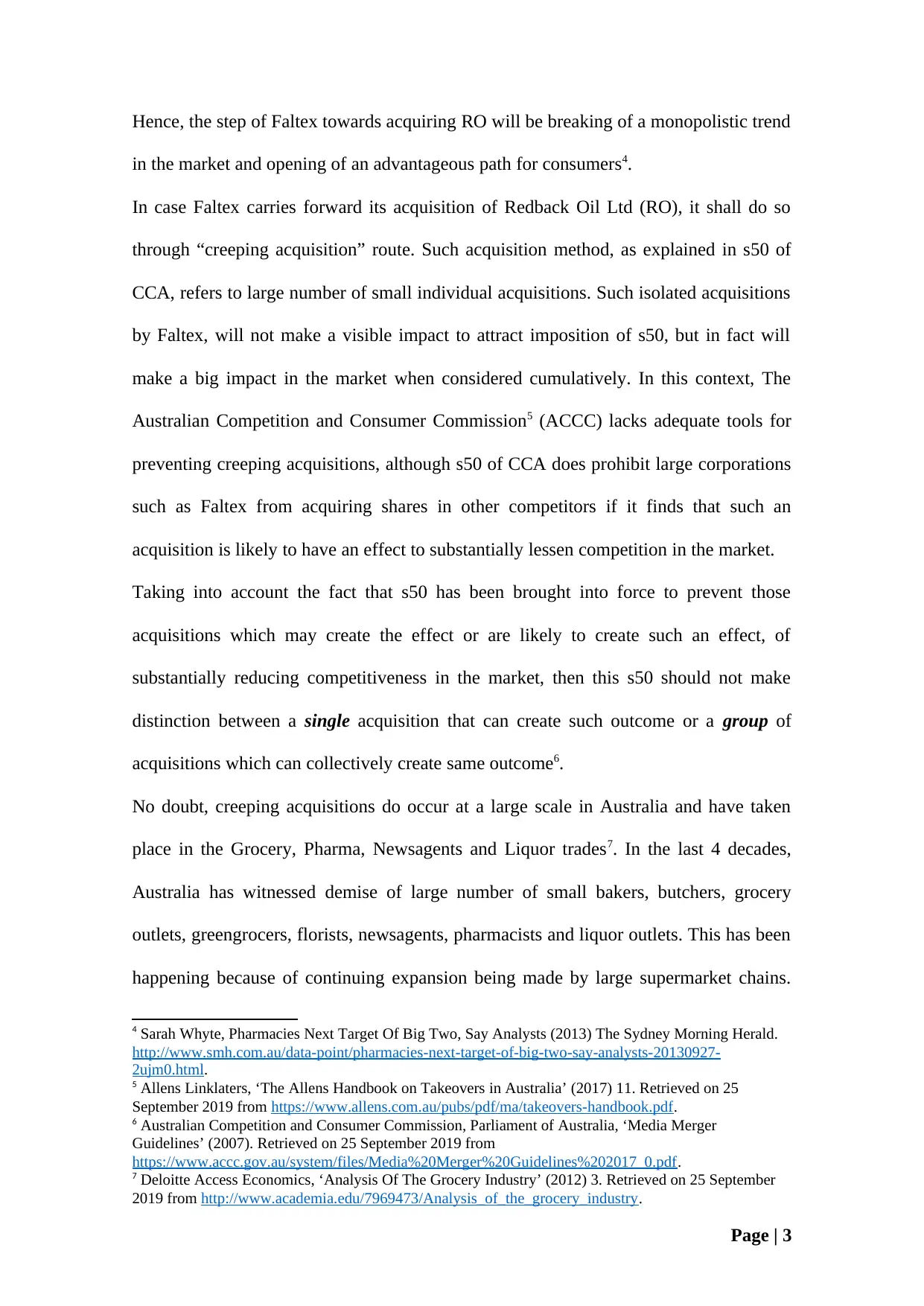
Hence, the step of Faltex towards acquiring RO will be breaking of a monopolistic trend
in the market and opening of an advantageous path for consumers4.
In case Faltex carries forward its acquisition of Redback Oil Ltd (RO), it shall do so
through “creeping acquisition” route. Such acquisition method, as explained in s50 of
CCA, refers to large number of small individual acquisitions. Such isolated acquisitions
by Faltex, will not make a visible impact to attract imposition of s50, but in fact will
make a big impact in the market when considered cumulatively. In this context, The
Australian Competition and Consumer Commission5 (ACCC) lacks adequate tools for
preventing creeping acquisitions, although s50 of CCA does prohibit large corporations
such as Faltex from acquiring shares in other competitors if it finds that such an
acquisition is likely to have an effect to substantially lessen competition in the market.
Taking into account the fact that s50 has been brought into force to prevent those
acquisitions which may create the effect or are likely to create such an effect, of
substantially reducing competitiveness in the market, then this s50 should not make
distinction between a single acquisition that can create such outcome or a group of
acquisitions which can collectively create same outcome6.
No doubt, creeping acquisitions do occur at a large scale in Australia and have taken
place in the Grocery, Pharma, Newsagents and Liquor trades7. In the last 4 decades,
Australia has witnessed demise of large number of small bakers, butchers, grocery
outlets, greengrocers, florists, newsagents, pharmacists and liquor outlets. This has been
happening because of continuing expansion being made by large supermarket chains.
4 Sarah Whyte, Pharmacies Next Target Of Big Two, Say Analysts (2013) The Sydney Morning Herald.
http://www.smh.com.au/data-point/pharmacies-next-target-of-big-two-say-analysts-20130927-
2ujm0.html.
5 Allens Linklaters, ‘The Allens Handbook on Takeovers in Australia’ (2017) 11. Retrieved on 25
September 2019 from https://www.allens.com.au/pubs/pdf/ma/takeovers-handbook.pdf.
6 Australian Competition and Consumer Commission, Parliament of Australia, ‘Media Merger
Guidelines’ (2007). Retrieved on 25 September 2019 from
https://www.accc.gov.au/system/files/Media%20Merger%20Guidelines%202017_0.pdf.
7 Deloitte Access Economics, ‘Analysis Of The Grocery Industry’ (2012) 3. Retrieved on 25 September
2019 from http://www.academia.edu/7969473/Analysis_of_the_grocery_industry.
Page | 3
in the market and opening of an advantageous path for consumers4.
In case Faltex carries forward its acquisition of Redback Oil Ltd (RO), it shall do so
through “creeping acquisition” route. Such acquisition method, as explained in s50 of
CCA, refers to large number of small individual acquisitions. Such isolated acquisitions
by Faltex, will not make a visible impact to attract imposition of s50, but in fact will
make a big impact in the market when considered cumulatively. In this context, The
Australian Competition and Consumer Commission5 (ACCC) lacks adequate tools for
preventing creeping acquisitions, although s50 of CCA does prohibit large corporations
such as Faltex from acquiring shares in other competitors if it finds that such an
acquisition is likely to have an effect to substantially lessen competition in the market.
Taking into account the fact that s50 has been brought into force to prevent those
acquisitions which may create the effect or are likely to create such an effect, of
substantially reducing competitiveness in the market, then this s50 should not make
distinction between a single acquisition that can create such outcome or a group of
acquisitions which can collectively create same outcome6.
No doubt, creeping acquisitions do occur at a large scale in Australia and have taken
place in the Grocery, Pharma, Newsagents and Liquor trades7. In the last 4 decades,
Australia has witnessed demise of large number of small bakers, butchers, grocery
outlets, greengrocers, florists, newsagents, pharmacists and liquor outlets. This has been
happening because of continuing expansion being made by large supermarket chains.
4 Sarah Whyte, Pharmacies Next Target Of Big Two, Say Analysts (2013) The Sydney Morning Herald.
http://www.smh.com.au/data-point/pharmacies-next-target-of-big-two-say-analysts-20130927-
2ujm0.html.
5 Allens Linklaters, ‘The Allens Handbook on Takeovers in Australia’ (2017) 11. Retrieved on 25
September 2019 from https://www.allens.com.au/pubs/pdf/ma/takeovers-handbook.pdf.
6 Australian Competition and Consumer Commission, Parliament of Australia, ‘Media Merger
Guidelines’ (2007). Retrieved on 25 September 2019 from
https://www.accc.gov.au/system/files/Media%20Merger%20Guidelines%202017_0.pdf.
7 Deloitte Access Economics, ‘Analysis Of The Grocery Industry’ (2012) 3. Retrieved on 25 September
2019 from http://www.academia.edu/7969473/Analysis_of_the_grocery_industry.
Page | 3
⊘ This is a preview!⊘
Do you want full access?
Subscribe today to unlock all pages.

Trusted by 1+ million students worldwide
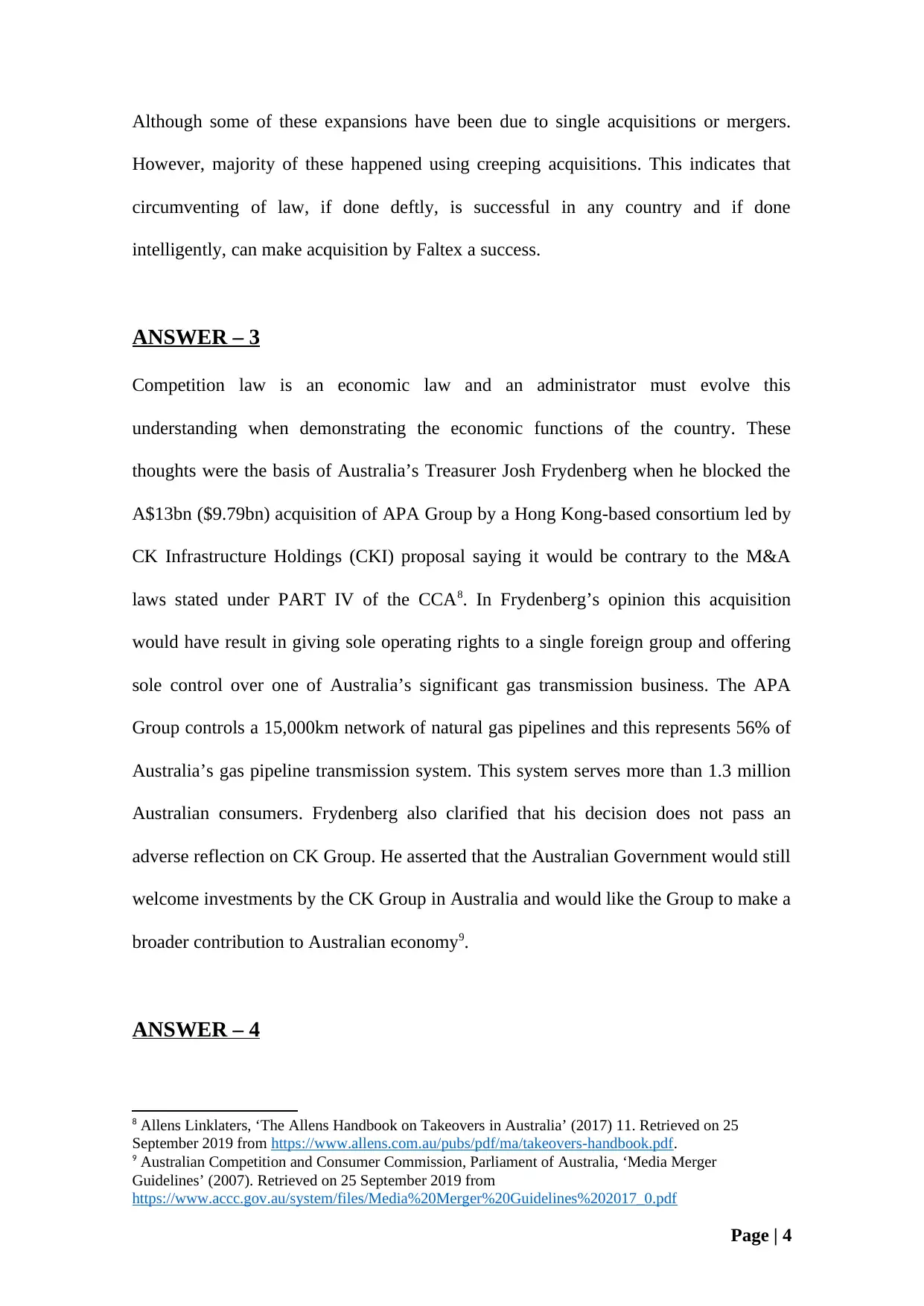
Although some of these expansions have been due to single acquisitions or mergers.
However, majority of these happened using creeping acquisitions. This indicates that
circumventing of law, if done deftly, is successful in any country and if done
intelligently, can make acquisition by Faltex a success.
ANSWER – 3
Competition law is an economic law and an administrator must evolve this
understanding when demonstrating the economic functions of the country. These
thoughts were the basis of Australia’s Treasurer Josh Frydenberg when he blocked the
A$13bn ($9.79bn) acquisition of APA Group by a Hong Kong-based consortium led by
CK Infrastructure Holdings (CKI) proposal saying it would be contrary to the M&A
laws stated under PART IV of the CCA8. In Frydenberg’s opinion this acquisition
would have result in giving sole operating rights to a single foreign group and offering
sole control over one of Australia’s significant gas transmission business. The APA
Group controls a 15,000km network of natural gas pipelines and this represents 56% of
Australia’s gas pipeline transmission system. This system serves more than 1.3 million
Australian consumers. Frydenberg also clarified that his decision does not pass an
adverse reflection on CK Group. He asserted that the Australian Government would still
welcome investments by the CK Group in Australia and would like the Group to make a
broader contribution to Australian economy9.
ANSWER – 4
8 Allens Linklaters, ‘The Allens Handbook on Takeovers in Australia’ (2017) 11. Retrieved on 25
September 2019 from https://www.allens.com.au/pubs/pdf/ma/takeovers-handbook.pdf.
9 Australian Competition and Consumer Commission, Parliament of Australia, ‘Media Merger
Guidelines’ (2007). Retrieved on 25 September 2019 from
https://www.accc.gov.au/system/files/Media%20Merger%20Guidelines%202017_0.pdf
Page | 4
However, majority of these happened using creeping acquisitions. This indicates that
circumventing of law, if done deftly, is successful in any country and if done
intelligently, can make acquisition by Faltex a success.
ANSWER – 3
Competition law is an economic law and an administrator must evolve this
understanding when demonstrating the economic functions of the country. These
thoughts were the basis of Australia’s Treasurer Josh Frydenberg when he blocked the
A$13bn ($9.79bn) acquisition of APA Group by a Hong Kong-based consortium led by
CK Infrastructure Holdings (CKI) proposal saying it would be contrary to the M&A
laws stated under PART IV of the CCA8. In Frydenberg’s opinion this acquisition
would have result in giving sole operating rights to a single foreign group and offering
sole control over one of Australia’s significant gas transmission business. The APA
Group controls a 15,000km network of natural gas pipelines and this represents 56% of
Australia’s gas pipeline transmission system. This system serves more than 1.3 million
Australian consumers. Frydenberg also clarified that his decision does not pass an
adverse reflection on CK Group. He asserted that the Australian Government would still
welcome investments by the CK Group in Australia and would like the Group to make a
broader contribution to Australian economy9.
ANSWER – 4
8 Allens Linklaters, ‘The Allens Handbook on Takeovers in Australia’ (2017) 11. Retrieved on 25
September 2019 from https://www.allens.com.au/pubs/pdf/ma/takeovers-handbook.pdf.
9 Australian Competition and Consumer Commission, Parliament of Australia, ‘Media Merger
Guidelines’ (2007). Retrieved on 25 September 2019 from
https://www.accc.gov.au/system/files/Media%20Merger%20Guidelines%202017_0.pdf
Page | 4
Paraphrase This Document
Need a fresh take? Get an instant paraphrase of this document with our AI Paraphraser

The CCA does not provide an explanation of the terms Merger and Acquisition.
Australian authorities consider merger as a commercial concept and not a legal one.143
According to The 2017 Media Merger Guidelines notified by ACCC with regard to s50
of CCA mergers are considered as transactions in which the shareholders of two
merging companies eventually end up as shareholders of the merged company.10144 An
example of such a merger is the merger of Coles Variety Stores and Myer Emporium
Ltd in 1985 which created a new entity Coles Myer Ltd.11145 Acquisitions, as per
ACCCC are those transactions which help the acquiring company to acquire shares and
assets of the target company.12146 Thus in an acquisition, the acquiring company expands
its size and the target company is entirely eliminated. A fitting case is the acquisition of
the Coles Group in 2007 by Wesfarmers which resulted in the suspension of Coles
Group activities and emergence of Wesfarmers as an expanded company.
10 Competition and Consumer Act, 2010 (Cth) s50(6).
11 Deloitte Access Economics, ‘Analysis Of The Grocery Industry’ (2012) 3. Retrieved on 25 September
2019 from http://www.academia.edu/7969473/Analysis_of_the_grocery_industry
12 Wesfarmers Limited, Wesfarmers – Corporate Transactions (2015). Retrieved on 25 September 2019
from https://www.wesfarmers.com.au/investors/shareholder-information/corporate-transactions.html
Page | 5
Australian authorities consider merger as a commercial concept and not a legal one.143
According to The 2017 Media Merger Guidelines notified by ACCC with regard to s50
of CCA mergers are considered as transactions in which the shareholders of two
merging companies eventually end up as shareholders of the merged company.10144 An
example of such a merger is the merger of Coles Variety Stores and Myer Emporium
Ltd in 1985 which created a new entity Coles Myer Ltd.11145 Acquisitions, as per
ACCCC are those transactions which help the acquiring company to acquire shares and
assets of the target company.12146 Thus in an acquisition, the acquiring company expands
its size and the target company is entirely eliminated. A fitting case is the acquisition of
the Coles Group in 2007 by Wesfarmers which resulted in the suspension of Coles
Group activities and emergence of Wesfarmers as an expanded company.
10 Competition and Consumer Act, 2010 (Cth) s50(6).
11 Deloitte Access Economics, ‘Analysis Of The Grocery Industry’ (2012) 3. Retrieved on 25 September
2019 from http://www.academia.edu/7969473/Analysis_of_the_grocery_industry
12 Wesfarmers Limited, Wesfarmers – Corporate Transactions (2015). Retrieved on 25 September 2019
from https://www.wesfarmers.com.au/investors/shareholder-information/corporate-transactions.html
Page | 5
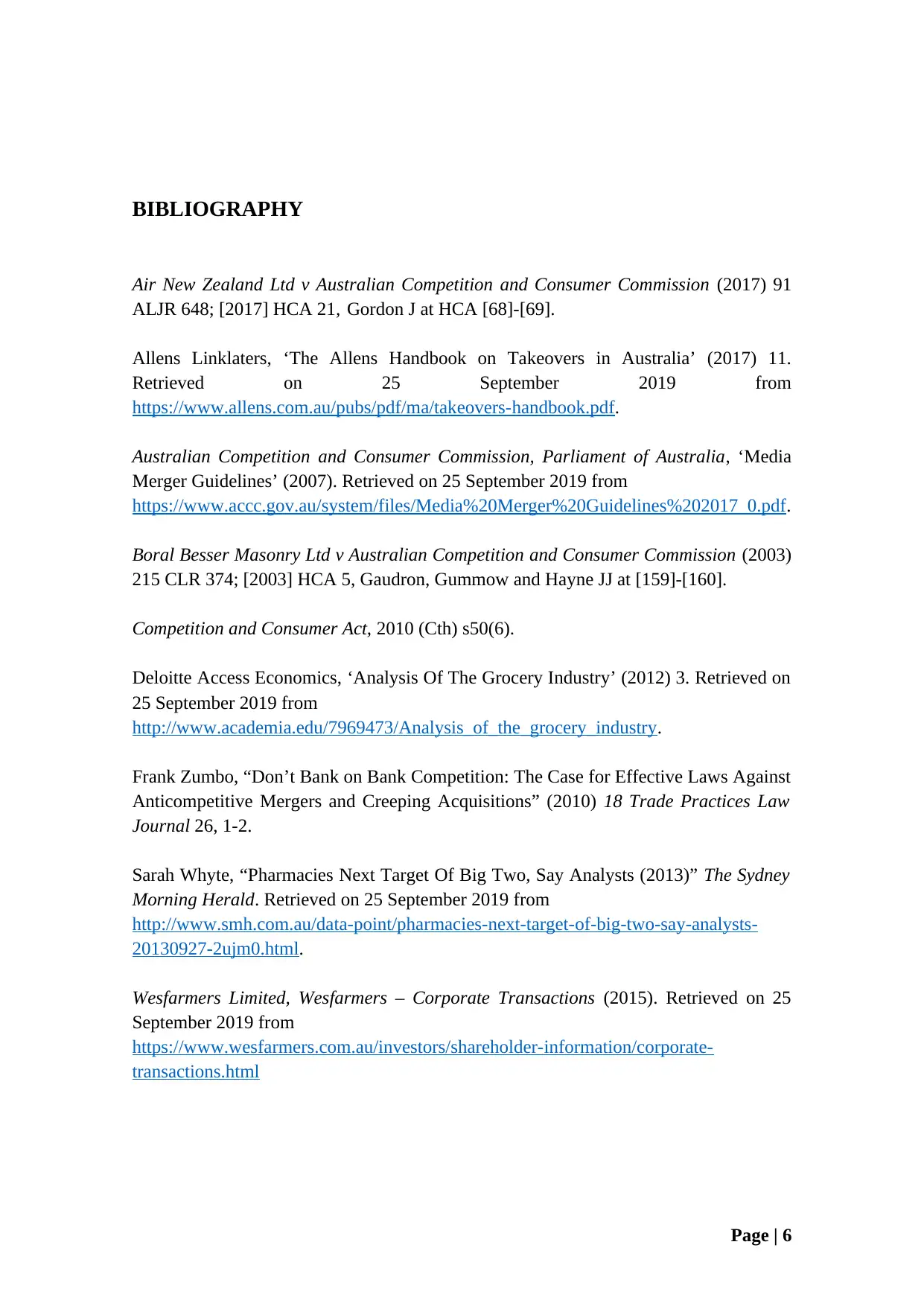
BIBLIOGRAPHY
Air New Zealand Ltd v Australian Competition and Consumer Commission (2017) 91
ALJR 648; [2017] HCA 21, Gordon J at HCA [68]-[69].
Allens Linklaters, ‘The Allens Handbook on Takeovers in Australia’ (2017) 11.
Retrieved on 25 September 2019 from
https://www.allens.com.au/pubs/pdf/ma/takeovers-handbook.pdf.
Australian Competition and Consumer Commission, Parliament of Australia, ‘Media
Merger Guidelines’ (2007). Retrieved on 25 September 2019 from
https://www.accc.gov.au/system/files/Media%20Merger%20Guidelines%202017_0.pdf.
Boral Besser Masonry Ltd v Australian Competition and Consumer Commission (2003)
215 CLR 374; [2003] HCA 5, Gaudron, Gummow and Hayne JJ at [159]-[160].
Competition and Consumer Act, 2010 (Cth) s50(6).
Deloitte Access Economics, ‘Analysis Of The Grocery Industry’ (2012) 3. Retrieved on
25 September 2019 from
http://www.academia.edu/7969473/Analysis_of_the_grocery_industry.
Frank Zumbo, “Don’t Bank on Bank Competition: The Case for Effective Laws Against
Anticompetitive Mergers and Creeping Acquisitions” (2010) 18 Trade Practices Law
Journal 26, 1-2.
Sarah Whyte, “Pharmacies Next Target Of Big Two, Say Analysts (2013)” The Sydney
Morning Herald. Retrieved on 25 September 2019 from
http://www.smh.com.au/data-point/pharmacies-next-target-of-big-two-say-analysts-
20130927-2ujm0.html.
Wesfarmers Limited, Wesfarmers – Corporate Transactions (2015). Retrieved on 25
September 2019 from
https://www.wesfarmers.com.au/investors/shareholder-information/corporate-
transactions.html
Page | 6
Air New Zealand Ltd v Australian Competition and Consumer Commission (2017) 91
ALJR 648; [2017] HCA 21, Gordon J at HCA [68]-[69].
Allens Linklaters, ‘The Allens Handbook on Takeovers in Australia’ (2017) 11.
Retrieved on 25 September 2019 from
https://www.allens.com.au/pubs/pdf/ma/takeovers-handbook.pdf.
Australian Competition and Consumer Commission, Parliament of Australia, ‘Media
Merger Guidelines’ (2007). Retrieved on 25 September 2019 from
https://www.accc.gov.au/system/files/Media%20Merger%20Guidelines%202017_0.pdf.
Boral Besser Masonry Ltd v Australian Competition and Consumer Commission (2003)
215 CLR 374; [2003] HCA 5, Gaudron, Gummow and Hayne JJ at [159]-[160].
Competition and Consumer Act, 2010 (Cth) s50(6).
Deloitte Access Economics, ‘Analysis Of The Grocery Industry’ (2012) 3. Retrieved on
25 September 2019 from
http://www.academia.edu/7969473/Analysis_of_the_grocery_industry.
Frank Zumbo, “Don’t Bank on Bank Competition: The Case for Effective Laws Against
Anticompetitive Mergers and Creeping Acquisitions” (2010) 18 Trade Practices Law
Journal 26, 1-2.
Sarah Whyte, “Pharmacies Next Target Of Big Two, Say Analysts (2013)” The Sydney
Morning Herald. Retrieved on 25 September 2019 from
http://www.smh.com.au/data-point/pharmacies-next-target-of-big-two-say-analysts-
20130927-2ujm0.html.
Wesfarmers Limited, Wesfarmers – Corporate Transactions (2015). Retrieved on 25
September 2019 from
https://www.wesfarmers.com.au/investors/shareholder-information/corporate-
transactions.html
Page | 6
⊘ This is a preview!⊘
Do you want full access?
Subscribe today to unlock all pages.

Trusted by 1+ million students worldwide
1 out of 6
Your All-in-One AI-Powered Toolkit for Academic Success.
+13062052269
info@desklib.com
Available 24*7 on WhatsApp / Email
![[object Object]](/_next/static/media/star-bottom.7253800d.svg)
Unlock your academic potential
Copyright © 2020–2025 A2Z Services. All Rights Reserved. Developed and managed by ZUCOL.